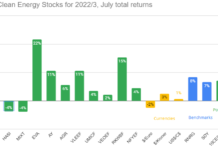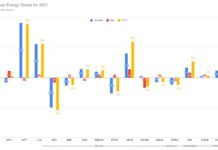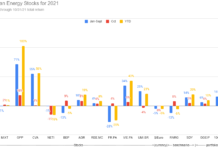John Petersen
The second quarter was brutal for publicly traded energy storage companies which saw their stock prices fall by an average of 24.1% after a first quarter drubbing of 16.2%. Frankly I’m astonished that investors are chasing a battery-powered IPO like Tesla Motors (TSLA) and ignoring the energy storage technologies that will make EVs possible, and perhaps cost-effective, while making wind, solar and other renewable energy sources stable. At times like these I need to remind myself that energy storage is the beating heart of cleantech and take comfort in the fact that while Goldman Sachs began covering advanced batteries as a sector on June 27th, I’ve been focused on the energy storage sector for almost two years.
The following table provides comparative second quarter performance data and key valuation metrics for the 17 pure-play energy storage companies I track. All values have been adjusted to reflect disclosed material changes since the last reporting date. In the working capital columns, I’ve included my subjective assessment of working capital adequacy based on historical operating results and disclosed capital spending plans. The “Blue Sky” value is the spread between the book value shown on a company’s balance sheet and its current market capitalization. For this quarter only, I’ve included Tesla as an honorary member because it’s blue sky premium equals 118% of the blue sky premium for the 17 energy storage companies combined.

The following graph compares the composite price performance of my five categories with the Dow Jones Average since November 14, 2008, when I first started tracking the sector.

The following table summarizes the portfolio performance a hypothetical investor would have realized over the last three months if he invested $1,000 in each company and the three broad market indexes on March 31, 2010.
| Broad Market Indices | -11.29% |
| Cool Emerging Companies | -31.47% |
| Cool Sustainable Companies | -10.71% |
| Cheap Emerging Companies | -35.19% |
| Cheap Sustainable Companies | -17.94% |
| Chinese Battery Companies | -25.23% |
Cool Emerging Companies
My Cool Emerging Companies category includes four companies that are developing cool but expensive energy storage technologies that are not yet commercialized. The companies in this category are Ener1 (HEV), Valence Technology (VLNC), Altair Nanotechnologies (ALTI) and Beacon Power (BCON). The Cool Emerging group fell an average 31.47% in Q-2 and have fallen an average of 58.65% since November 2008.
The following table provides quarterly price information for each company’s stock and is accompanied by a graph that illustrates their relative price performance compared with their closest peers and the Dow.

Valence, Ener1 and Beacon do not have sufficient working capital to support their operating losses and capital spending plans for more than three to six months without relying on financing transactions where shares are sold into the public market on a regular basis for the purpose of providing working capital, which can put significant pressure on stock prices. Until their working capital positions improve, I’d be cautious.
While Altair will likely need additional financing within the next year, it does not appear to have any pressing needs and its low market capitalization of $31.6 million and miniscule blue sky premium of $1.7 million leave significant room for outsized gains if it successfully implements its business plan.
Cool Sustainable Companies
My Cool Sustainable Companies category includes three companies that manufacture cool but expensive energy storage devices and generate substantial recurring revenue. The companies in this category are A123 Systems (AONE), Maxwell Technologies (MXWL) and Ultralife (ULBI). The Cool Sustainable group fell an average 10.71% in Q-2 and have fallen an average of 2.47% since November 2008
The following table provides quarterly price information for each company’s stock and is accompanied by a graph that illustrates their relative price performance compared with their closest peers and the Dow.

In the Cool Sustainable category Ultralife strikes me as a bit of a sleeper because of its diversified product lines and customer base. It has larger revenues and smaller losses than either of its peers and is currently trading at a modest discount to book value. It certainly merits further analysis.
Cheap Emerging Companies
My Cheap Emerging Companies category includes two companies that are developing effective and objectively cheap energy storage technologies that are not yet commercialized. The companies in this category are Axion Power International (AXPW.OB) and ZBB Energy (ZBB). The Cheap Emerging group fell an average 35.19% in Q-2 and have fallen an average of 43.51% since November 2008.
The following table provides quarterly price information for each company’s stock and is accompanied by a graph that illustrates their relative price performance compared with their closest peers and the Dow.

ZBB does not have enough working capital to support its operating losses and capital spending plans for more than three to six months without relying on financing transactions where shares are sold into the public market on a regular basis for the purpose of providing working capital. ZBB’s recently announced financing plans are more company friendly than others I’ve reviewed, but future pressure on its stock price cannot be ruled out. Conversely its miniscule market capitalization of $7.3 million and very small blue sky premium of $3.3 million leave significant room for outsized gains if it successfully implements its business plan.
In the two emerging company categories, Axion Power is
the only company with enough working capital to support a couple years of operations and significant expansion of its manufacturing capacity.
Cheap Sustainable Companies
My Cheap Sustainable Companies category includes four companies that manufacture effective but objectively cheap energy storage devices and generate substantial recurring revenue from product sales. The companies in this category are Enersys (ENS), Exide Technologies (XIDE) C&D Technologies (CHP) and Active Power (ACPW). The Cheap Sustainable group fell an average 17.94% in Q-2, but gained an average of 76.43% since November 2008.
The following table provides quarterly price information for each company’s stock and is accompanied by a graph that illustrates their relative price performance compared with their closest peers and the Dow.

Chinese Battery Companies
My Chinese Battery Companies category includes four companies that manufacture a variety of energy storage devices including lead-acid, NiMH and lithium-ion batteries, and generate substantial recurring revenue from product sales. The companies in this category are Advanced Battery Technology (ABAT), China BAK Batteries (CBAK), China Ritar Power (CRTP) and Hong Kong Highpower (HPJ). The Chinese Battery group fell an average 25.23% in Q-2, but has risen an average of 36.69% since November 2008..
The following table provides quarterly price information for each company’s stock and is accompanied by a graph that illustrates their relative price performance compared with their closest peers and the Dow.

China BAK is very weak from a working capital perspective and has not publicly disclosed its plans to remedy the problem. Until its working capital position improves, I’d be cautious.
My Murky Crystal Ball
For two years I’ve been telling readers why energy storage will be a core enabling technology for the cleantech revolution and cautioning that valuations in the cool technology groups were less attractive than valuations in the cheap technology groups. On that basis alone, I’ve consistently suggested that the cool technology groups were likely to stagnate or underperform on a go-forward basis while the cheap technology groups were likely to outperform. I think the comparative price performance charts say it all.
These are heady times because times and technologies are changing rapidly and risky times because many of the highest profile technologies like electric vehicles are not cost-effective and may never reach that goal. In my opinion, the biggest challenge for energy storage investors is separating business reality from press release hype and establishing a realistic timeline for expected changes in the energy storage sector.
During the information and communications technology revolution, we got used to the idea that Apple (AAPL) could announce a new product and sell millions of copies within a few months. In cleantech the development timelines will be longer and until we build a substantial experience base with some of these exciting new technologies, adoption rates will be slow and uncertain. One of the most useful graphs I’ve seen for energy storage and cleantech investors is set forth below.

My last table is arranged in declining order of blue sky premiums and summarizes where I believe the pure-play energy storage companies I track fit on the technology adoption lifecycle graph.

For my investment dollar, companies that have already crossed the chasm, together with developers like Maxwell and Axion that have a good shot at crossing the chasm in the next 12 to 18 months are better opportunities than riskier business models that face a three to five year development cycle and uncertain customer acceptance.
Disclosure: Author is a former director of Axion Power International (AXPW.OB) and holds a substantial long position in its stock.








What is happening to Axion?
What is happening to Axion?
For several months substantially all the volume was flowing through a single market maker, which generally indicates liquidation by a major holder in distress. Since there have been no Form 4 filings, we know it’s not an insider or one of the big private placement purchasers.
I suspect the rest is probably people who bought the private placement planning on a quick flip who’ve grown tired of waiting. I’ve never invested that way so I don’t understand it, but you get some in every deal.
I have not heard anything that leads me to believe the selling has anything to do with business fundamentals.